| the 2005 CanAm
CL16 Regatta Hilton Beach, August 6-7 report by Uncle Al ... |
|
Hilton
Beach
CanAm CL16 Regatta provides marvellous
weekend
of sailing, parties and just plain fun! "Oh oh! It
looks
like 3854 has tacked too soon and won't lay the
mark. No ... wait! He's
getting lifted ... and he just squeezes
around the mark. Now
he's off in a nice puff towards the leeward mark.
And here comes 523,
Steve Macklin with son, Andrew, who may have
an edge down this
run with his lighter crew weight. This is it, folks,
the final race of
the 2005 CanAm Regatta with the winner taking home
the Hilton Beach Cup
and a purse of $1200."
Imagine getting a tack-by-tack report of your racing progress broadcast live to fans watching from stands on shore, or better yet, from the verandah of the Tilt'n Hilton, which looks out onto one of the finest, most scenic sailing venue that you will ever see! And this was just one of the many uniquely enjoyable aspects of the second annual CanAm CL16 White Sail Regatta hosted by the North Channel YC of Desbarats and the Village of Hilton Beach August 6-7. Warm, sunny weather and lovely winds of 10 to 20 knots made the spectacular venue on a lake-like stretch of the St. Mary's River east of Sault Ste Marie even more beautiful. The event attracted 24 CL's from as far away as Manitoba and Ottawa, who competed for the generous purse of $7500 put up by our sponsors, Phelps Media Group, Inc. International. One of those entries was the team of Uncle Al and Marc Bennett who borrowed a cottage CL from Mike Codd's crew, Kirk Iredale, and got just the conditions they excel in: oscillating off-shore breezes. In the end, the SHADES team won all five races, two lovely trophies and $3400 to put towards a trip to the Denmark Wayfarer Worlds in 2007. The town, its people, our hosts, the parties - everything in fact - was just perfect for a glorious weekend, one that Marc and I would have enjoyed every bit as much, even if we had won nothing. Regatta news is now being posted under "news" on the CanAm Regatta site - see http://hiltonbeach.com/regatta/, with more coverage this site, too. 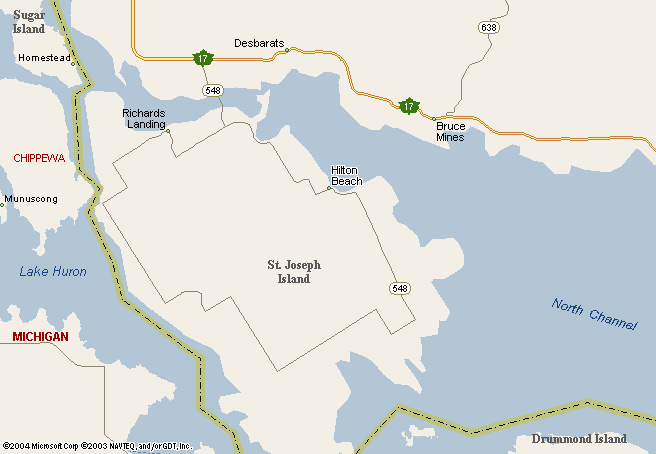 Marc and Al started their 9-hour drive from Oakville, just west of Toronto, on Thursday night after supper, making it to Sudbury with just one hour of rain. After a good night's sleep and a futile hunt for a Starbuck's in that town, we were off like Marc's proverbial "herd of screaming turtles". 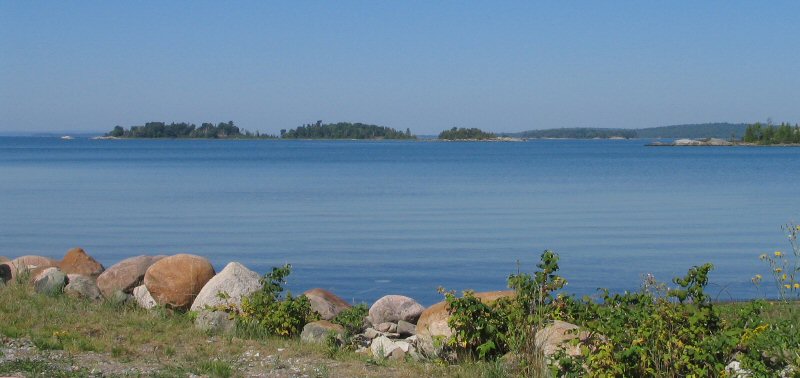 Soon we were getting glorious glimpses of the North Channel from Hwy 17 (see photo above) and were reminded of our legendary Wayfarer cruiser, Don Davis, who, in one of his many fine logs, talked of hitting "the fleshpots of Thessalon", a town on the North Channel about halfway between Sudbury and Sault Ste. Marie. Months of weekly winter strategy sessions at Toronto's Ben Wicks pub finally became our reality as we arrived at the Hilton Beach Marina in glorious warm sunshine late Friday morning (see photo below). 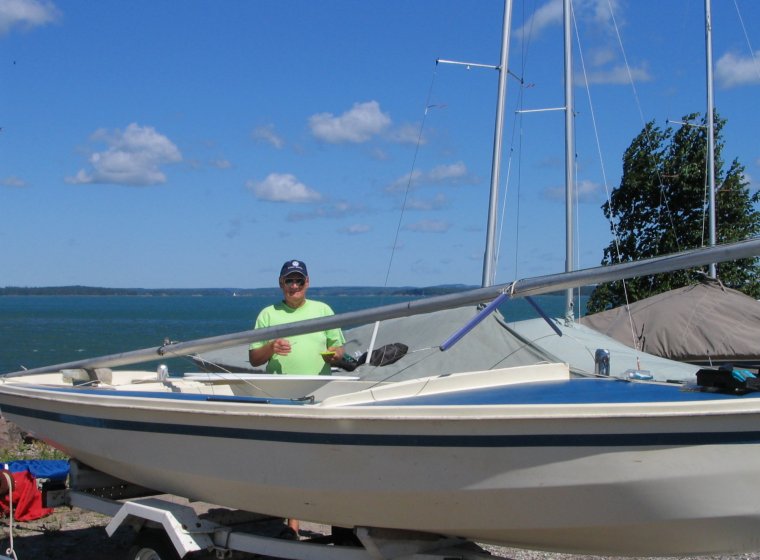 It quickly became evident that the generous purse provided by Mason Phelps was not going to - as Marc and I had feared it might - affect the Corinthian nature of the competition. Fellow competitors and and hosts alike were unfailingly friendly and helpful! Along with the perfect weather and the unique social calendar, this made for a regatta that ranks as one of the most enjoyable among the hundreds and hundreds of fine regattas it has been my privilege to sail over my 50+ years of racing. Allowing the competitors, the many volunteers and the people living in and around Hilton Beach to get to know each other a bit, was a lovely reception and competitors' briefing in the bar of the Tilt'n Hilton, where Marc and I had a fine supper before retiring to our tent next door in the scenic (photo below) Hilton Beach Tourist Park (Charlie Nelson 705-246-2586). 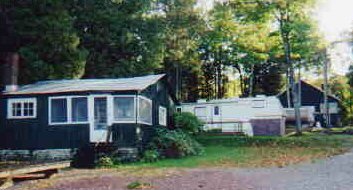 Saturday morning dawned sunny and refreshingly cool after the stifling heat we'd been getting day and night in the Toronto area. Having spent Friday night acquiring local knowledge, Marc and I were off early to catch the 7 a.m. opening of Ann's Café in Richards Landing, about 15 minutes' drive from Hilton Beach (see map above). Ann's turned out to be every bit as excellent as the lovely Tilt'n Hilton waitresses had promised: a lovely, quiet, quaint place to sit and soak up atmosphere while enjoying a bacon, eggs and homemade toast breakfast cooked to perfection (see photo below). 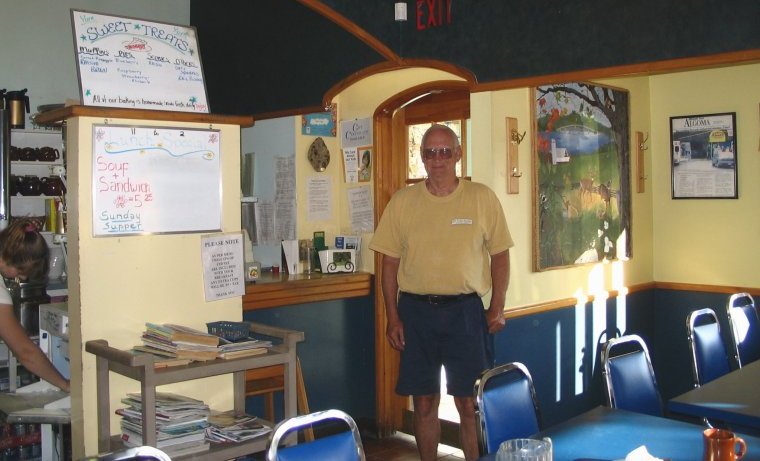 A fit way to get set for the day's three scheduled races which would start at 10 a.m. Experience has taught Marc and me to become better prepared for any eventuality, so we made sure that we gained the most essential local knowledge, the fact that even on a Sunday, Ann's would be open at 7 a.m. The Hilton Beach Marina manager, Greg Marshall, had very kindly waived the mooring fee for visiting regatta participants, so our "machine" was already in the water, having been thoroughly scrubbed and cleaned of assorted cottage-related algae. By the time we arrived at 8 o'clock, all we had left to do was to confirm that our Wayfarer main, duly disguised with a CL emblem courtesy of Heider Funck, would actually slide up the sail track of our CL's mast. Failing that, we would need to use Kirk's CL628 cottage main, a fate not to be welcomed. Not counting the fact that someone had blocked the mast track up to three feet above boom level with a track that accommodates a sliding gooseneck but not the bolt rope of the main, our sail went up swimmingly - so to speak. An attempt to duct-tape a compass to the thwart was abandoned as too messy, and we decided to base our shift playing on apparent angles to the nicely regular shore line on both sides of the spacious St. Joseph Channel (below), the site of our race course. 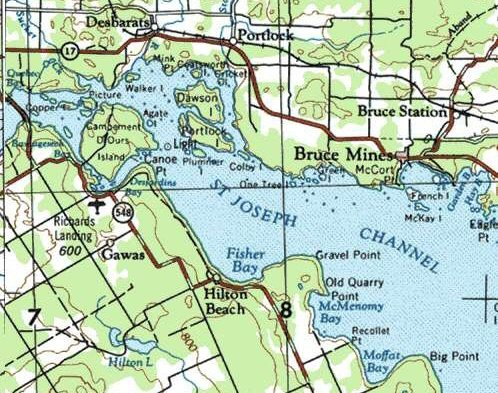 Weatherwise,
it was a
typical sunny summer's morning with light and
patchy winds from the NE
as we headed out for race 1 which would be
followed by a civilized
on-the-water lunch break. After sailing upwind to
check for wind shifts
and oscillations, the moment of truth arrived for
Marc who would now
have to prove that he was as good with a whisker
pole as he had claimed
many a time at the Wicks. Marc was indeed
fast, but there was
one problem: our 20 feet of continuous jib sheet
was fine for a
Wayfarer that normally uses a spinnaker, but
considerably too short to
accommodate a whisker pole. No problem: Marc
hauled our 15-foot 5mm.
painter out of our Hans Gottschling portable
spinnaker/storage bag and
tied it to the jib clew while untying one end of
our regular 20 feet
of 7 mm. jib sheet. Now we had two jib sheets -
albeit of differing
diameters - that we amply long enough for whisker
pole use.
As race time neared, we worked on a game plan for the first beat. A current check at the start mark seemed to indicate a very slight westerly flow, but Marc's attempt to confirm this failed when the handful of dust he found in the bottom of the boat and threw overboard beside the mark indicated a downward current by sinking. We decided that current need not be a major factor in our plans, and turned our attention to the wind which we thought looked fairly steady across the course but might funnel and be stronger along the near shore with a possible lift for starboard tack nearer to Gravel Point (see map above and photo below). So, we decided to try the right side of the course. But with no really urgent reason to go there, we would be open to changing our plan.  At the windward mark, it was Al by perhaps a hundred yards over Kipp. While we sailed the rhumb line of the run with slight departures from it to go up in the lulls and down with the puffs, Kipp led a closely packed group of boats who sailed high on port tack and seemed to get more wind - or perhaps Ann's much lighter crew weight was beginning to tell. Whatever it was, Kipp looked poised to pass us or at least get buoy room at the leeward mark. Being confident of our upwind speed, we did not get too worried by this possibility, so long as we rounded within striking distance of Kipp. Instead of worrying, we put our time to more productive use by planning our second-beat strategy as we dawdled along downwind. In the event, we arrived at the leeward mark still two or three lengths ahead of Kipp. By this time, we had agreed that we would defend the left side of the course and not let any of the leaders get out there before us. Kipp was the first of the leaders to tack, and we tacked the moment he did. Staying at least as far left as our nearest pursuers worked well, especially since we found that we could outpoint or outspeed them by just a bit. On this beat, the two leaders pulled away from the fleet to some extent (perhaps by going left sooner?), and at the windward mark, Al and Marc had worked into a lead of some 200 yards over Kipp, a lead we were afraid we would need against Kipp's and Ann's demonstrated off-wind speed. Down the run, we again looked for puffs to sail down with but this time, we also made sure we went as far left off the rhumb line as Kipp did - which was not too far. This time, we were pleasantly surprised to hold our lead down the run, and at the leeward mark, we were in the comfortable position of being able to hold port around the mark for half the lead, then tack to starboard, and tack once more to port as Kipp rounded. This not only allowed us to avoid the disturbed air and water of the large fleet coming down the middle of the run, but also put us into the textbook position from which to defend our lead: directly between the opponent and the next mark. This meant that Kipp would have to go through us to reach the finish line ahead of us, and anything short of a complete calm followed by new and different wind, should leave us in a position to hold (at least some of) our lead. The size of our lead also gave us a nice cushion in our covering task, such that, when Kipp tacked, we were able, several times, to delay our covering tack until we could take advantage of a better streak of wind. Thus, the "rich got richer" as we sailed to a comfortable win, while Kipp and Ann took a comfortable second place. A comeback for Belleville's Steve and Andrew Macklin fell just short of 3rd place money as they were held off by defending champions, Jim and Alice Hill of the North Channel YC. Locals, Mac and Nick Thomas took 5th place ahead of the Brampton father-daughter team of John and Laura Kupers. Four NCYC entries followed as Becky Sylvester with Andrew Bignell took 7th ahead of Eric Kirby with Gary Gjos, and the Warren team of Richard and Merrill. Rounding out the top ten were first-beat leaders, Alfred Gawthrop and Craig Bouck. As the fleet picked up their lunches from several boats of volunteers and then headed back to the start area just off the marina, the NE wind died. However, the bad news did not last long, as the common SW lake breeze off Lake Huron began to come in hot gusts across St. Joseph Island (see map below). 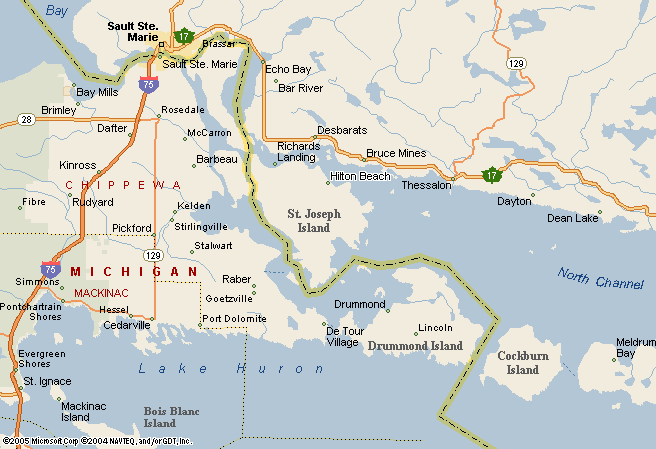 As the dead zone between the NE weather system wind and the SSW lake breeze slowly made its way northward, the RC (in the capable hands of North Channel YC Commodore, Mason Phelps Jr.) duly moved the start area about a mile and a half off the Hilton Beach shore, correctly anticipating that the SSW breeze would establish its dominance over our sailing area. Typically, such an offshore breeze gusts and oscillates, and this day's breeze was no exception. Soon we were romping around in a lovely 10 to 15 knots with the occasional gust into the 20's, classic hot summer's day conditions for this part of the Lake Huron-dominated area (see photo below). Still, not everyone was romping: Marc and I hove to with the board full up and lounged, which let us relax, save our strength and talk strategy. An overwhelming number of factors were telling us to go left up the beat (i.e. the shortest route to the Hilton Beach (windward) shore:
Of course, things are rarely that simple. In this case, the committee had again favoured the port end of the line, so that - with the boat once more at that end - it might well be impossible to cross the line on starboard anywhere near the committee boat, depending on which oscillation was in place: starboard lifted or port lifted. 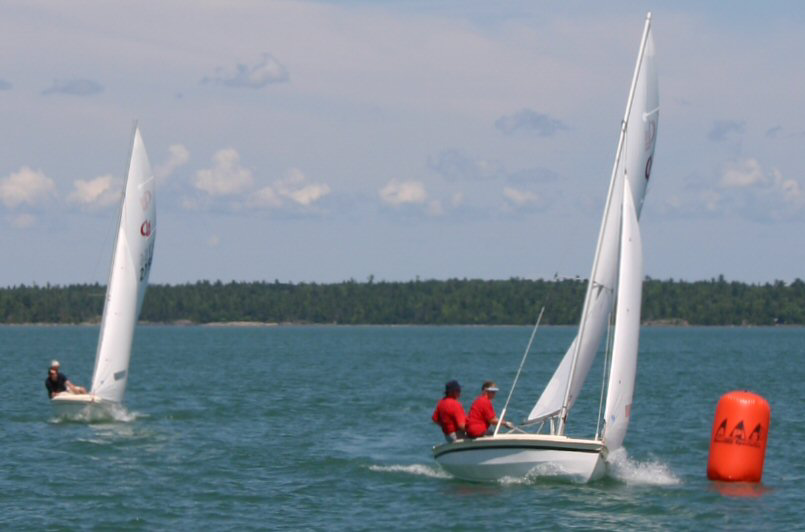 Race 2 (Olympic triangle): Again, we opted for discretion and started two thirds down the line from the favoured end, where we could at least tack with the "gun" to get onto the (currently) vastly favoured port tack. After our tack, much of the fleet was to windward of us, having also tacked. Mindful of our game plan, we took the first excuse to tack to starboard, in this case, bad air from several boats who were sailing down over top of us. We crossed behind a good half dozen boats but were on our way towards the shore. A long starboard tack took us through several lifts and headers. We ignored the latter until we were well inshore and then began to look for that juicy starboard knock that would really favour port tack. Sticking to your guns in these conditions requires real mental toughness and good judgment. In this case, the boats on the extreme right really looked - from time to time - like they would wipe us, as they got huge starboard lifts. Our juicy port lift never came, so we tacked on a little port lift, still short of the port lay line, so that a better port lift would still shorten our distance to the mark. And coming in along the shore towards the mark, the mark, we did indeed get some great port lifts plus consistently strong puffs. Meanwhile, the boats coming in on starboard from the far right, sometimes looked for a little while like they would cross us easily, got more and more starboard headers and less wind strength on average, so that it became clearer and clearer that we should be in good shape at the mark. Nearer the mark, we got a couple of brief major port knocks which we could still profitably tack on, having taken care to avoid getting right out to the layline. In the end, we got the last laugh/puff, and rounded with a lead that would last us the entire race. We built on that lead on the beats by defending the favoured left side against the nearest pursuers. What with various spectator boats watching as we neared the finish line, we tried extra hard not to do anything visibly stupid. Marc and I were quite pleased as we got the "gun", and moved into relax mode. After getting clear of boats still racing, we hove to, and enjoyed watching the developing finish line excitement. An impressive showing by two light-weight teams as Steve Macklin with young son, Andrew, and John Supers with daughter, Laura, placed 2-3, while Kipp and Ann Sylvester made their second straight top five appearance with a 4th. Coburg's Colin Junkin and Heather Wood put it all together in this one, and placed 5th, beating out locals, Jim Hill, Becky Sylvester and Richard Warren. Moving into the top ten for the first time were 9th-place Peter and Jim Foster of the North Channel YC, and Tony and Stu Cond (10th) out of Ottawa's Nepean SC.  Race 3 (windward-leeward): The lake breeze continued to become a bit more robust as the day's final race drew near. On our boat, we saw nothing that should cause us to re-think our strategy from race 2, as conditions were very similar to those of the previous race, except that the gust cells were perhaps becoming bigger and stronger (photo above). This time, the RC gave us a line that was nicely square to the mean wind direction, and when the last couple of minutes brought a starboard-tack favoured phase of the oscillating breeze, Marc and I decided that we could indulge ourselves with an attempt at the now favoured windward (starboard) end of the line. Everything went well, and we were just getting up speed for the start right beside the mark in the final five seconds, when misfortune struck. Glenn Penner in 1916 came careering down on a full plane broad reach around the start mark from windward and tried to squeeze into the rapidly shrinking space between our bow and the line. We bore away as much as we could to try to avoid a collision while yelling "Up! Up!" but to no avail. Glenn's boom hooked onto our forestay and he began to tow us down the line as the "gun" went. By the time we got free, we were well and truly buried behind several boats, but Glenn paid even worse: his jib halyard snapped from the strain and he had to stop (see photo below) and jury-rig a replacement while the fleet sailed off without him. We discovered after the race, that Glenn's CL had come from the builder with a supposedly standard 1/16" jib halyard, an arrangement so Mickey Mouse that it would be laughable as an attempt to scrimp and save a few pennies, were it not for the safety factor involved. In my opinion, the jib halyard should move up two thicknesses to 1/8" diameter, to match the shroud diameter, because the jib halyard does, after all, take at least as much load as the shrouds do under most conditions. 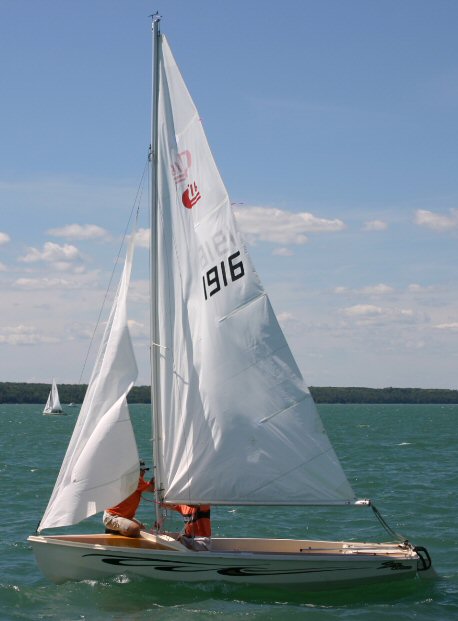 Fortunately for us, the wind was by now strong enough, that even sailing in dirty air did not leave seriously wind-deprived. So we moved along towards our preferred left side of the beat and did some boat speed testing against Becky Sylvester who had placed 3rd in the inaugural CanAm series. What with the series of big puffs hitting us fairly frequently, Marc and I thought longingly of the 42:1 vang system we have on the Wayfarer, a marked contrast to the 3:1 "Laser vang" that we had set to max tension on our CL before the start of the race. It wasn't overly tight but seemed to be doing a reasonable job as we waited for that big starboard knock that would let us tack to port into clear air. When it finally came, we got a brief port-tack ride into clear air before we got on with the task of going left onto starboard on the first small port-tack header, this time in clear air. Beyond that, the race went much like race 2 aboard our boat: we again went near the port layline and rolled in along the south shore and discovered that the left side had once again been kind to us, as we rounded onto the first run with a surprisingly healthy lead. Carrying a great puff around the windward mark, we screamed off down the run and never felt threatened after that. Another excellent 2nd saw the Macklins, Steve and Andrew, move into series 2nd as of the end of the first day's racing, while Jim and Alice Hill took a fine 3rd just behind the Macklins. This moved the Hills into a virtual 3rd-place tie with Kipp and Ann Sylvester going into the final day of the series. Continuing to improve their finishes as they day wore on, were Peter and Jim Foster whose 3rd-race 4th ahead of Kipp and Ann would be the highlight of their series. 6th place went to NCYC's Alfred Gawthrop and Craig Bouck ahead of clubmates, Eric Kirby and Gary Gjos. Mac and Nick Thomas crossed 8th while behind them, Charles Marquardt made his first top ten appearance of the day in 9th, ahead of John and Laura Kupers. What with the excellent winds, we were pretty much off the water by 4:30 or so and had lots of time to compare notes and have a few beers before it was time to shower in preparation for the 6 p.m. Sailors' BBQ in the Hilton Beach Town Hall. In addition to having a fine feed, Marc and I very much enjoyed the many lovely paintings of northern scenes put on display around the hall by local artist, Doug Hook, whom I got to meet and chat with during my all too frequent trips to the smoking lounge (a.k.a. front steps) where there was a seemingly endless parade of good-looking ladies to admire. We did get inside briefly for more drinks and to check out the great slide shows that were illustrating the day's action as Jake Cormier had captured it. And I kept meaning to go inside to catch the Ross Phillips Band who - from the little I could hear outside - were playing my kind of music, but Marc and I were having so much fun chatting with new acquaintances that before we knew it, the hall was being closed down, and we had to move back down the block to the Tilt'n Hilton where Marc and I basked in the glow of a great day's sailing and success until they, too, were set to close. We finally rolled into our tent next door well after midnight, being dimly aware that we needed to get up before 7 o'clock to make our breakfast date at Ann's. There was no visible breeze in Richards Landing as I checked the wind direction with cigarette smoke outside Ann's on a sunny, warm Sunday morning, but when Marc and I got back to the Marina, the signs of a healthy SSW breeze were already spreading across the sparkling blue water - no NE preamble to the day's winds this time. With the slightly lighter morning winds taking up where they had left off the previous afternoon (photo below), we saw no reason to change our plan that had worked so well in races 2 and 3.  Race 4 (Olympic triangle): Another nice, square line from the RC allowed all of us to pick a nice spot to start. All we wanted from this start was clear air, preferably near the pin end where we would be safe from getting hung up on the RC boat's anchor line if the wind should swing to the left at the last second, and at the same time, be well placed to re-round to re-start (since the I flag - round-the-ends rule - was in effect throughout the series). This time, we finally managed to start both well placed and with clear air. Just as we had mentally diagrammed it, we started near the pin and again played the left side. This once more worked well and we were the first around the windward mark. As we started our first reach in a nice planing-strength puff, we were perhaps 100 yards up on Steve and Andrew Macklin, who were being closely pursued by Alfred Gawthrop and Craig Bouck who had made some overnight adjustments that were evidently working to good effect. As we had feared, the lighter Macklins closed the gap on the first reach despite our best efforts, and were only a couple of lengths behind at the gybe mark. On the second reach, the Macklins went well high of the rhumb line and got better wind, moving past us into the lead just before the leeward mark. Had this been the last leg of the race, we would have defended (much) more strenuously, but here, we still had two beats and a run to go, so that we were (reasonably) happy to start beat 2 in a great attacking position, just off the Macklins' transom. Marc and I had already decided that nothing had changed regarding our preference to go left on the beat, and that we would tack to starboard right around the mark - something we knew the Macklins could not afford to do since we were so close to their transom that they would have to tack too close to us and foul us in order to do so. This strategy worked to perfection, and by the time the Macklins tacked to starboard a minute or two later, we were in a perfect position to use our slightly better pointing to pinch up and eventually move up over their bow. But getting ahead was not enough. We knew from the reaches, that Steve and Andrew would be fast on the run, too, and thus had to try to increase our lead to "put some money into the bank". We again went left and essentially "sailed our own race", playing the shifts while making sure none of the leaders got further inshore sooner than we did. Marc was finding it tough to tack well in the more constricted forward quarters of the CL, but managed to hide this from the onlookers who seemed to think we had been tacking very well. And Marc's difficulties surely did not slow us down, as we rounded onto the run with a sizeable lead which we held to the finish. Second place was a battle right to the finish as Alfred and Craig held on to edge out the surprising Macklins, Steve and Andrew. Jim and Alice Hill took 4th and thus maintained at least a mathematical chance of beating out the Macklins for series 2nd, which they could do by winning the finale while the Macklins finished no higher than 4th - the Hills would then win the tie-breaker. It was a fine 5th place for Becky Sylvester and Andrew Bignell, a much better showing than their 14th in race 3 where Becky had tired badly. Both John Kupers (6th) and Kipp Sylvester (7th) maintained their slim hopes of taking series third, while Peter Foster (now sailing with Peggy Foster) took 8th and remained well placed for an overall finish in the money (top 7). Completing the top 10 were Tony and Stu Cond who edged out Mac and Nick Thomas. There now followed a rather lengthy wait before the grand finale scheduled for 1 p.m.: the race for the new Hilton Beach Cup, which, as you can see below, is really a lovely silver plate, donated by the village of Hilton Beach. As we waited
for the
big event, boats staffed by volunteers sought us
out and delivered
lunches, which we had lots of time to eat and
digest - but not in peace
and quiet. By now, the increasing warmth of the
day was stirring up the
winds until the gusts were regularly reaching 20+
knots, and most of
the boats were screaming around on wild planes.
Marc and I, on the
other hand, were content to heave to with board
full up, lounge, and
watch the show. We'd get ample action soon enough!
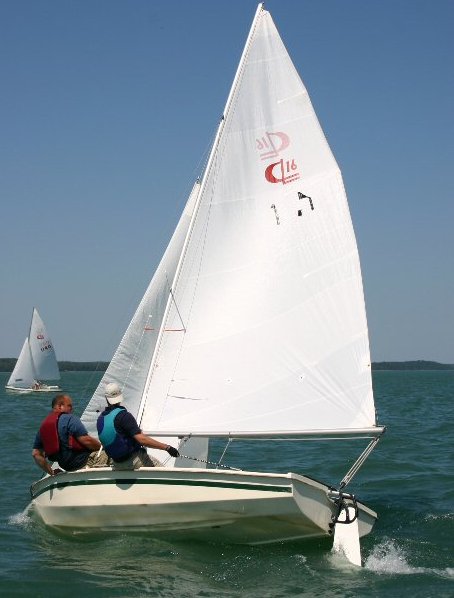 Race 5 (Olympic triangle) - The Hilton Beach Cup: Except for a few lulls in the slowly increasing SSW winds, nothing had changed. The RC once more gave us a lovely line that was square to the median wind direction, and we were soon off, chasing each other and the new Cup with its $1200 first prize. I don't remember much that sticks out about this race, except that it was great sailing, especially on the planing reaches. Aboard 3854, our speed, pointing, tacks and strategy were good, and when you have all that, you tend to do well. A good-sized lead at the windward mark let us spend the rest of the race playing it safe: sticking to the rhumb line overlaid with "up in the lulls, down with the puffs" on the free legs, and loosely covering the nearest threats while defending the left side going upwind. What can I say? It was a lovely day, one that will live forever among my happiest memories. With an impressive final-race 2nd ahead of Jim and Alice Hill, Steve and Andrew Macklin confirmed their runners-up status, while the defending champion Hills had to be content with series 3rd. After a slow start - 19th in the opener - Tony and Stu Cond finished with a flourish, taking 4th in the finale, while Peter Foster scored a fine 5th. The latter thus moved into a 6th-place points tie with Alfred Gawthrop (8th in the finale) and Becky Sylvester (7th in the last race). The Appendix A tie-breaking procedure then gave the 6th overall nod to Alfred whose best finish was a 2nd, while Peter (best finish = 4th) placed series 7th and Becky Sylvester (best race = 5th) fell to 8th. I'm not sure that this was reflected at the awards ceremony but Marc and I were in such a happy haze, that we're not entirely sure. Anyways, back to the final-race top 10: 6th place went to Kipp Sylvester who thus nailed down an excellent series 4th after a nice consistent weekend during which he never placed lower than 7th. Kipp was, as mentioned, chased across the line by Becky and Alfred, after which came Charles Marquardt. John Kupers and his lovely but oh so light daughter, Laura, again suffered in the heavier going, falling to a 10th in the windier final race each day. So, they had to count one of their 10ths, but adding in their 6-3-6 finishes, they just squeezed into series 5th at 25 points, one up on the Alfred, Peter and Becky threesome. The 2005 CanAm Regatta then concluded with a fine spread of victuals laid out for us under the big tent outside the Tilt'n Hilton, which in turn was followed by the Awards ceremony. For Marc and me, this was somewhat of an embarrassment - if a very desired one - as we repeatedly got called up for race wins. And then there was the Hilton Beach Cup, presented to us by Hilton Village Reeve, Jack Hore (below, centre). 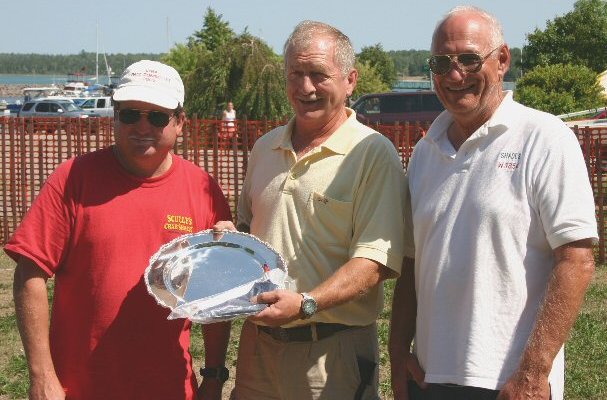 And of course,
NCYC of
Desbarats Commodore, Mason Phelps Jr., of Phelps Media
Group, Inc. International,
our main sponsor, presenting us (below) with
the
Can Am CL-16 Regatta Trophy.
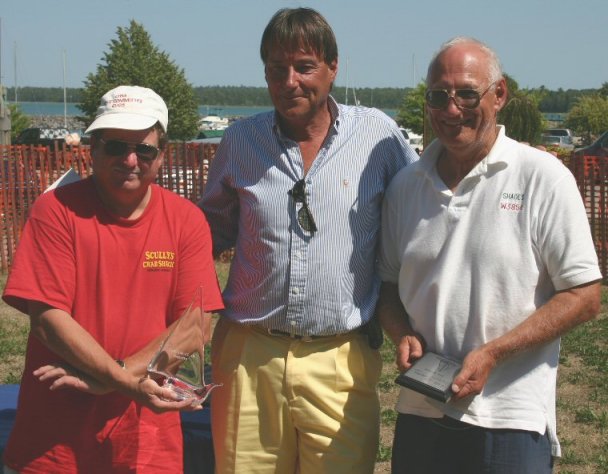 And just when we thought our glory-hogging was all done, we had yet another wonderful surprise: local artist, Doug Hook, had "doctored" one of his fine prints to make it CL 3854, and was presenting it to us! The moment (below) brought me to the edge of tears. Doug's fine work will have a place of honour in our family's living room at home in Oakville. (For more about Doug and his fine work, click here - or email Doug here) 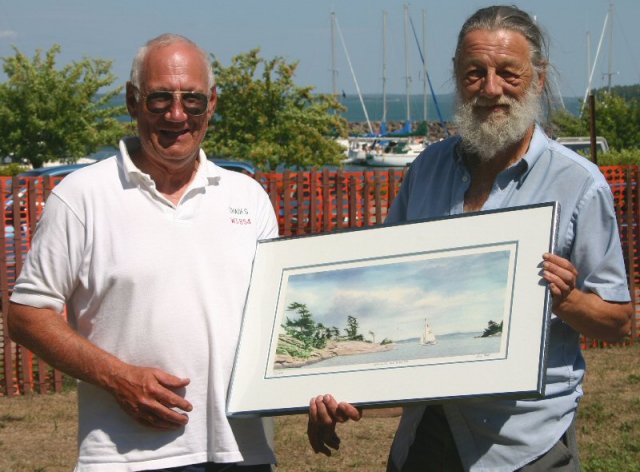 Lucky for Marc and me, that we had decided to spend another night here in our tent, because the afternoon's "business" was not yet over: Al got interviewed by Donna Schell of the Sault Star and North Shore Sentinel, and then talked to Jake Cormier and his video camera. After this, Marc was eager to drive to Sault Ste Marie and get a first-hand look at Lake Superior, that legend among lakes, but first we sat and had a beer while reflecting on how lucky we were to have had so many people go to so much effort in making this regatta the memorable weekend that it was. There will be dozens whose names and/or faces I don't know (yet), but there are some whom I can and will thank more specifically:
PS: And yes, we did get Marc (below) up for a lovely sunset over Lake Superior on Sunday evening: 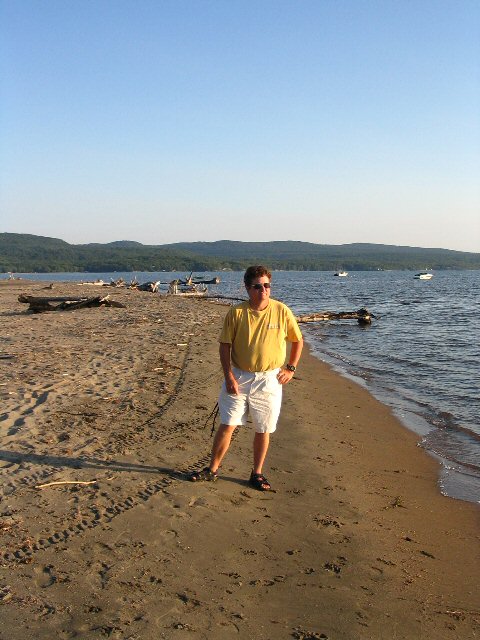 |
| return
to index page |